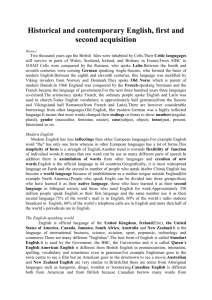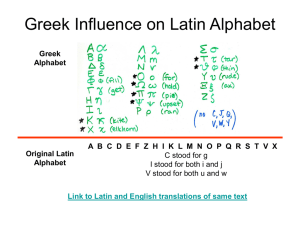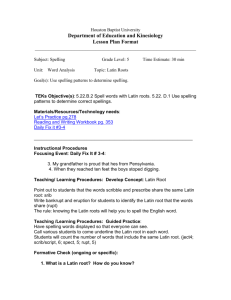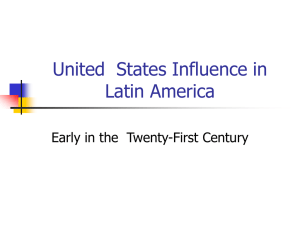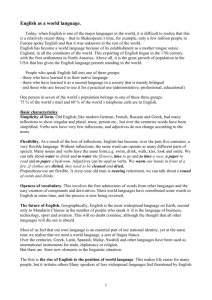The history of English language
advertisement
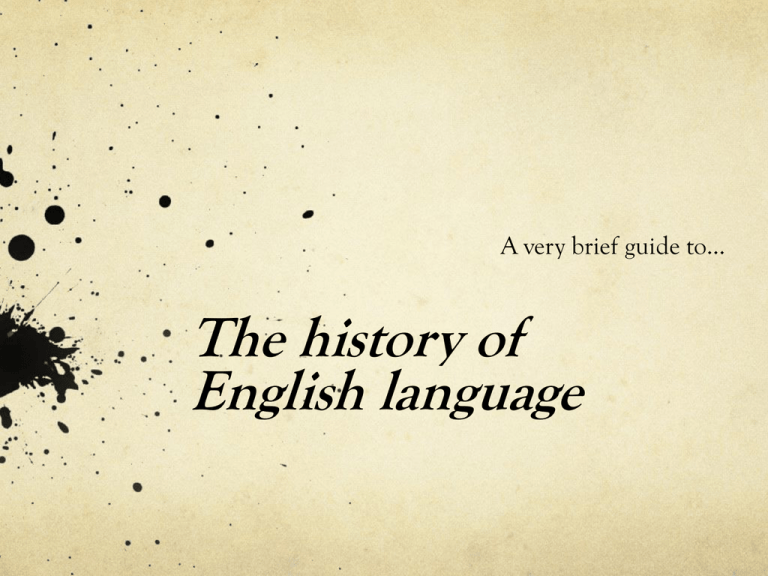
A very brief guide to… The history of English language Early beginnings • Before 100 B. C., Britain was populated by a mixture of tribes, including the Celts, Picts, Irish and Cornish. •They all spoke a variety of Celtic languages. The origins of English • In the 5th century AD, settlers from west Germany crossed over to Britain. • These tribes were called Saxons, Jutes and Angles, and set up kingdoms called ‘East Anglia’, ‘West Saxon’, etc. • They spoke a dialect of the Germanic language and this slowly evolved into the English we speak today. Old English (c. 400 - 1100 AD) • The language spoken by the Germanic settlers developed differently to the forms found in what is now known as Germany. • This early form of English is known as ‘Old English’. Influences during the Old English period Vikings invaders started arriving in north east England in the 8th century. Parts of their Scandinavian language (which is closely related to Germanic languages too), including words describing family and animals, spread through northern England. These words were integrated in Old English. Fæder ūre, ðū ðē eart on heofonum, Sī ðīn nama gehālgod. Tō becume ðīn rice. Gewurde ðīn willa On eorþan swā swā on heofonum. Urne gedægwhamlīcan hlāf syle ūs tōdæg. And forgyf ūs ūre gyltas, Swā swā wē forgyfaþ ūrum gyltendum. And ne gelæd ðū ūs on costnunge, ac alȳs ūs of yfele. Sōþlice. Middle English (c. 1100 – 1450 AD) When the Normans invaded in 1066, French became the dominant language (court, church, noble) while the rest of the country spoke versions of English. Latin remained the language of the Mass. Gradually English became more widely used by the educated upper classes and by 1425 English was used universally in speech and writing. However, English had chanced completely since the Old English period and became known as Middle English. Features of Middle English 1. Features of Middle English 2. French lexis Especially legal, religious and administrative terms such as justice, jury, govern, sovereign. Features of Middle English 3. Pronunciation Latin words No standardised system of spelling Thousand of Latin words, found in French, replaced Old English terms Pronunciation was changing with vowels becoming shorter (ex. leef became life and teem became time). An estimated 85% of Old English words fell out of use after the Vikings and Norman invasions. Early Modern English (c.1470-1700) In 1476, William Caxton introduced the printing press in Britain. Many text could be now mass.produced, which meant that there was a move towards standardization in how they were printed, in terms of spelling and punctuation. Many Greek and Latin text were translated into English. Caxton chose the East Midlands (london. Oxford, Cambridge) dialects to print works in. Thsi soon became the most prestigious form of English. Features of Early Modern English European Renaissance World exploration William Shakespeare • A huge number of Latin, French and Greek words entered the English language: words were needed for new concepts like psychology. • Brought words from African, Asian and New world languages. • Coined about 1700 new words such as : courtship, excitment, outbreak. Influences of Latin More than half of our Modern english vocabulary is LATINATE (of Latin origin), Ex.: colossal, dignified, emotion, history. Most of our prefixes and suffixes come from Latin, ex.: anti-, post-, pre-, -al, -ate, -ic. Late Modern English (c. 1700-modern day) From 1700 onwards, English became more standardised and similar to the language we recognise today. In 1755, Samuel Johnson finished the first ‘Dictionary of English’. Many writers had attempted this before but his version was more comprehensive than ever before. In 1762, Robert Lowth published the first English grammar book, which laid out some of the fundamental rules for ‘correct’ usage. Standardization and presctipvism During this time, many writers made attempts to define the lexicon and grammar of English (Johnson, Lowth,, etc). This led to a viewtha some no-standard varieties of English were inferior: this is called Presctipvism. Latin was upheld as the ideal language and used as a model for English grammar, even though it had a very different structure. th 19 century English Rail travel, colonial expansion, the spread of literacy and mass production of the printed word extended everyone’saccess to a standard written form of English. The Industrial Revolution changed the way people worked and lived their lives, so new words were needed. English borrowed huge numbers of words from all over the world. American English was becoming a language in its own right, with its own rules and spelling. Modern developments English is now a world language of communication. Electronic media like mobile phones and the internet have radically changed the way we communicate with each other. A more colloquial and casual style of language reflects major social changes. Estuary English (a south-eastern dialect) has become widespread in UK. American English increasingly influences British English and English worldwide.

